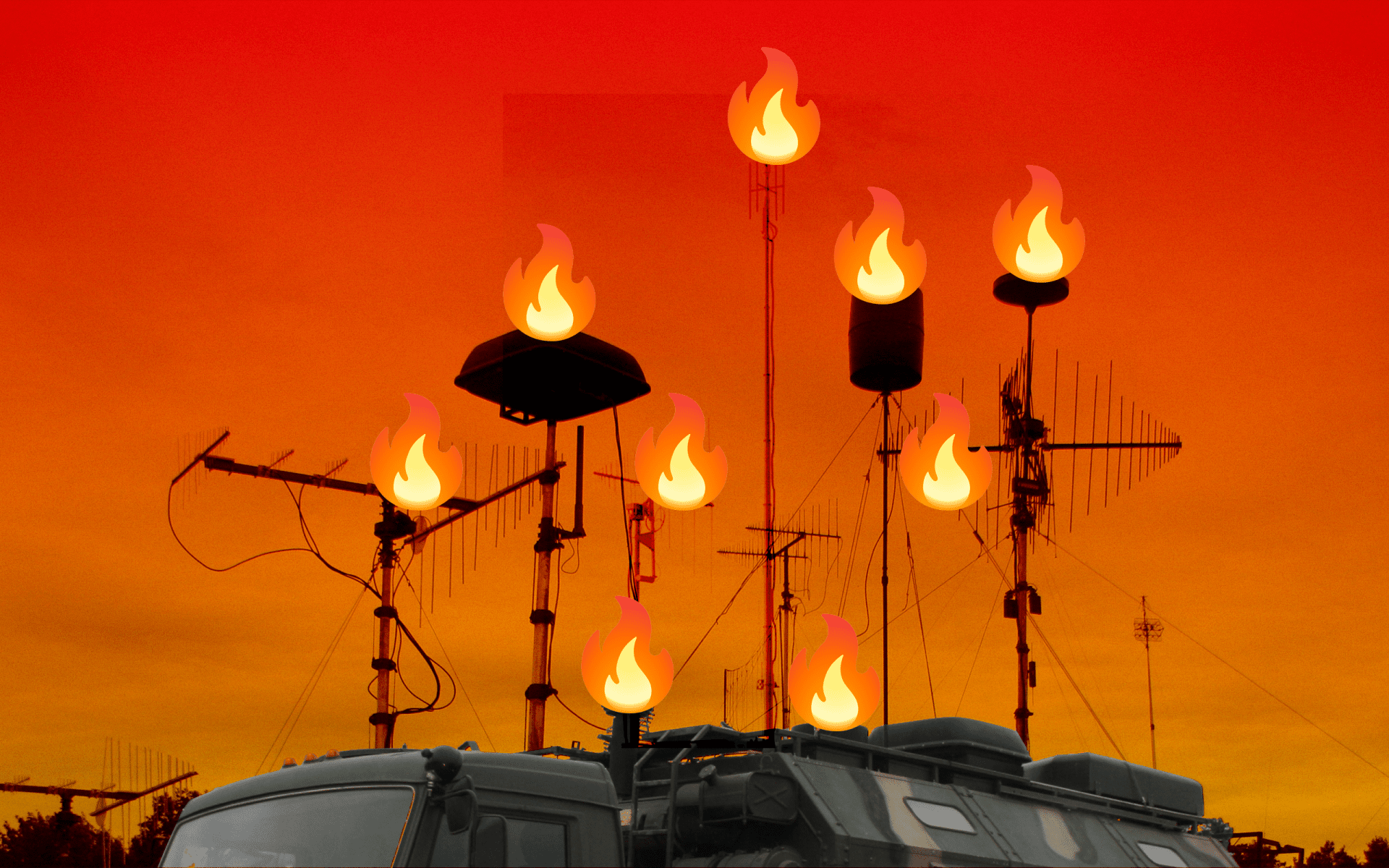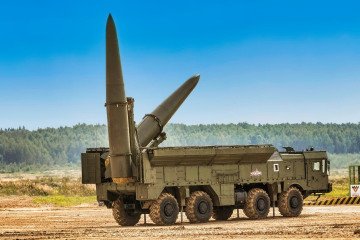- Category
- War in Ukraine
Russian Electronic Warfare Systems Ukraine Has Taken Down So Far

Russia’s electronic warfare systems—once seen as a key advantage on the battlefield—are falling fast. Ukraine has launched a string of successful strikes that are dismantling Russia’s prized EW arsenal. Which systems have been taken out, and how were they destroyed?
On March 29 panic spread among Russian troops, according to ATESH . Russia has begun relocating air defense and EW systems from temporarily occupied Crimea to areas of the Kherson region under Russian control, the partisan group said.
The shift is believed to be an attempt to “compensate for significant equipment losses” and the “high mortality rate” among Russian soldiers on the front line.
On that day Ukraine’s unnamed partisans destroyed a $230,000 Russian Lorandit electronic warfare (EW) system in the Kherson region by setting it on fire with flammable liquid, Ukraine’s Defence Intelligence reported. The system, used by Russian forces for radio jamming and electronic reconnaissance, was reduced to scrap.
The attack on the RP-377L Lorandit is an indicator of Ukraine’s successes in eliminating EW systems, and could be a factor in Russia’s “growing panic.”
Partisans and residents of the temporarily occupied Ukrainian territories have contributed substantially to Russian losses, according to ATESH. They urge those passing on information about Russia’s movements to Ukraine’s military forces to continue their resistance, adding that “every message is a contribution to the common victory.”
Russia’s EW capability has formed a key part of its armed forces, playing a crucial role in both offensive and defensive strategies. EW systems are pricey, and when destroyed, can have a severe strategic impact on Russia’s operations.
Eliminating Russia’s EW technology has also become vital to Ukraine’s defense efforts.
-cd2c40945e16486a17e6a4a5907b0f7a.png)
Ukraine has carried out several successful strikes against Russian EW systems. The Ukrainian military isn’t disclosing exact numbers, but if you go by MOLFAR ’s April 2023 analysis of official statements, over $1 billion worth of EW assets have been destroyed.
“I'm not ready to give you a number right now,” Ivan Pavlenko, Chief of the Main Directorate of Electronic Warfare and Cyber Security of the Ukrainian General Staff, told reporters in September 2023. “The total number from February 24 2022, will be within 80-120. It depends on what you count. Counting only large systems, it's 60-70."
The number of destroyed systems has undoubtedly increased since then. Ukraine’s Armed Forces have successfully struck several systems.
“Madyar,” an aerial reconnaissance unit with Ukraine’s 59th Brigade, released footage showing a devastating three-day assault in the Donetsk region from March 24 to 26. In that span, the unit destroyed 369 Russian targets, including EW systems, tanks, and armored vehicles. More than 100 Russian soldiers were reportedly killed.
Zhitel EW system
Ukrainian Forces successfully destroyed a $10 million R-330Zh “Zhitel” system in February. The OSINT group “KiberBoroshno” identified the targeted Russian EW system’s location near the village of Belitsa in the Kursk region. After confirming the coordinates, Ukrainian forces launched an artillery strike on the position and eliminated Russia’s prized Zhitel.
The Zhitel is a mobile truck-mounted electronic warfare jamming communication station that works to identify drone swarms in the area. Eliminating this EW system reduces Russia’s battlefield situational awareness and communications capabilities.
It’s not the first time the Zhitel has been targeted.
On the night of January 27-28, two expensive enemy electronic warfare systems R-330Zh “Zhitel” were destroyed in Voronezh, Russia. Ukraine’s Main Intelligence Directorate (HUR) confirmed that these Zhitels were due to be deployed to occupied Ukraine, but were destroyed before they could leave their manufacturing factory.
There is no official statement on how many Russian Zhitels have been destroyed by Ukraine’s Forces, but in April 2023, MOLFAR reported that 9 systems had already been destroyed.
Sapphire EW system
Special Operations Forces of the Ukrainian Armed Forces confirmed a successful strike against Russia’s Sapphire EW system in August 2024. Strike drones eliminated the system and also killed and wounded an unconfirmed number of Russian soldiers.
The Sapphire’s main capabilities are in countering unmanned aerial vehicles (UAVs), or drones, through automatic classification and suppression. It’s clear that in this case, the Sapphire was not at all effective.
Sinitsa EW system
A precision strike with two GMLRS rockets from a HIMARS system destroyed a Sinista EW system. The strike can be seen in a video released by Ukraine’s 45th Separate Artillery Brigade in October 2024.
The R-934B Sinitsa EW station is designed to jam aviation radio communications, tactical aircraft guidance systems, and fixed and mobile radio communications.
Ukrainian paratroopers also destroyed a Sinista system in June 2024. Paratroopers of Ukraine’s 71 Separate Chasseur Brigade said that without this system, Russian forces were left without any EW cover in the Kharkiv region.
Borisoglebsk-2 EW system
One of the most expensive EW systems in Russia’s arsenal, the R-330BMV Borisoglebsk-2, was destroyed using an FPV drone of Ukraine’s Mountain Assault Brigade’s “Taystra” unit.
This system's main capabilities are to detect and suppress various communication channels and other systems that use radio signals. MOLFAR reported that by April 2023, Ukraine destroyed ten of Russia’s prized systems. Each system is estimated to cost up to $200 million.
Leer-3 EW system
HIMARS successfully eliminated Russia’s Leer-3 system along with two of its Russian operators in the Zaporizhzhia direction, Militarnyi reported in April 2024.
The Leer-3 system’s main capabilities are reconnaissance, control, deception, and information operations. It works together with the Orlan 10 UAV against Ukrainian military cell phones, radar systems, and GPS.
The cost of one system is estimated at around $5 million. From the start of Russia’s full-scale invasion in February 2022 to January 2024, Ukraine destroyed two Leer-3s and 176 Orlan-10 UAVs, according to reports. Including the attack reported in April, the figure is likely to be much higher.
Krashuka-4
Ukraine destroyed Russia’s Krasukha-4 EW system in the Zaporizhzhia region in November 2024. Russian forces attempted to hide the equipment under camouflage netting but the 14th Separate Regiment successfully struck it with a drone, said Militarnyi.
The Krashuka-4 is extensively deployed in Ukraine, conducting reconnaissance and SIGINT (Signals intelligence) targeting radar systems and satellite communication up to 300km away. Priced at up to $2,600,000, it's thought of as one of Russia’s biggest EW tech losses.
Russian radars
Radars and EW systems are closely related and are often used in conjunction on the battlefield. A Russian radar capable of detecting Ukraine’s radar systems can then be used by Russia’s EW systems to block or disrupt them. Radars are also a key military target in Ukraine’s defense operations, and its military has seen many successful strikes throughout Russia’s full-scale invasion.
In February 2025, Ukraine’s 10th Mountain Assault Brigade “Edelweiss” used drones to destroy a Russian Zoopark-1 counter-battery radar in the Luhansk region. The radar was hit three times, and one drone was flown directly into an open hatch, igniting a fire that burned the system from the inside out.
1L219M Zoopark-1 radar is estimated to be worth $23.86 million per system. It’s designed for artillery reconnaissance and fire control, detecting firing positions of artillery, rocket launchers, and mortars. A pricey system to lose that has been victim to several successful strikes by Ukraine’s forces.
In December 2024, Ukraine’s armed forces confirmed a strike on the radar, likely by two precision-guided GMLRS rockets fired from HIMARS or M270 systems.
⚡️ Ukrainian defense forces have successfuly targeted a Russian Zoopark-M1 counter-battery radar.
— UNITED24 Media (@United24media) December 12, 2024
📹: Ukrainian Land Forces pic.twitter.com/3jC1GKJmU6
Just a month earlier, in November 2024, another Russian Zoopark-1 counter-battery radar was destroyed by Ukraine’s “Wings” unit from Ukraine’s HUR.
Ukraine’s 15th Separate Artillery Reconnaissance Brigade "Black Forest," successfully struck and destroyed a $40 million Russian 9S36 radar station, sharing the video on Facebook on March 12. The radar is vital to Russia’s BUK-M2 surface-to-air missile (SAM) system, guiding its missiles to their targets.
A high-value Russian 96L6E surveillance radar caught fire in Crimea on March 4. The 96L6E radar is critical to the operation of S-300 and S-400 air defense systems and an essential part of Russia’s S-400 air defense system, responsible for detecting high-altitude and medium-altitude aerial targets.
Ukraine’s Armed Forces successfully targeted and disabled a Russian Kasta radar station worth $60 million with a high-precision strike. The main components of the Kasta 35N6 radar—its antenna, electronics, and onboard systems—were likely damaged beyond repair. The exact location and date of the strike remain undisclosed.
Russia's nuclear ballistic missile early warning radar, located deep inside the country, was hit by drones. pic.twitter.com/lSqZmB1abb
— UNITED24 Media (@United24media) May 30, 2024

-46f6afa2f66d31ff3df8ea1a8f5524ec.jpg)
-c42261175cd1ec4a358bec039722d44f.jpg)
-6359eca46c72bde40a90abaaadd6eaa8.png)
-29a1a43aba23f9bb779a1ac8b98d2121.jpeg)


-206008aed5f329e86c52788e3e423f23.jpg)